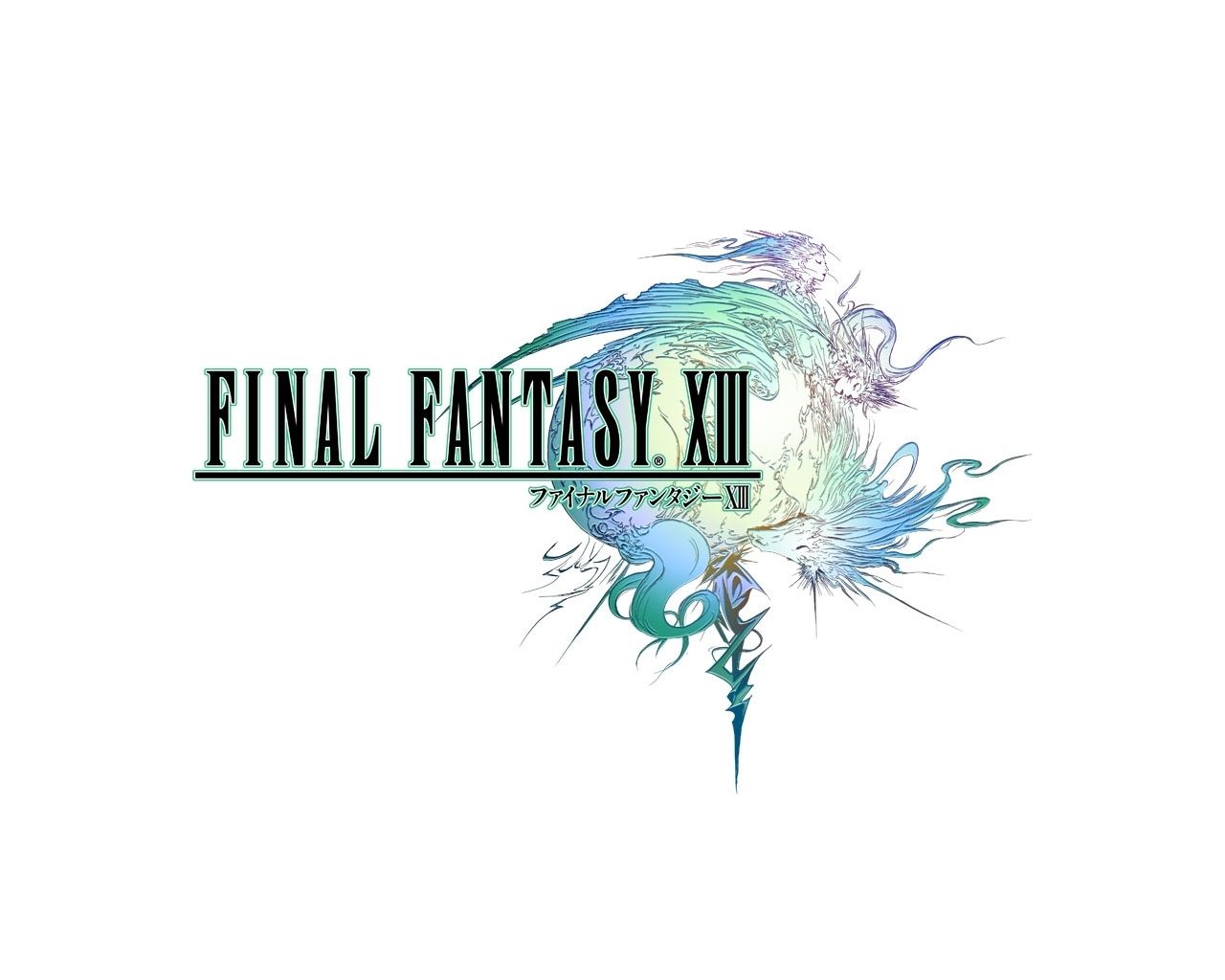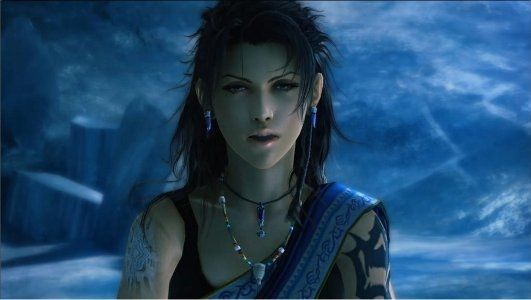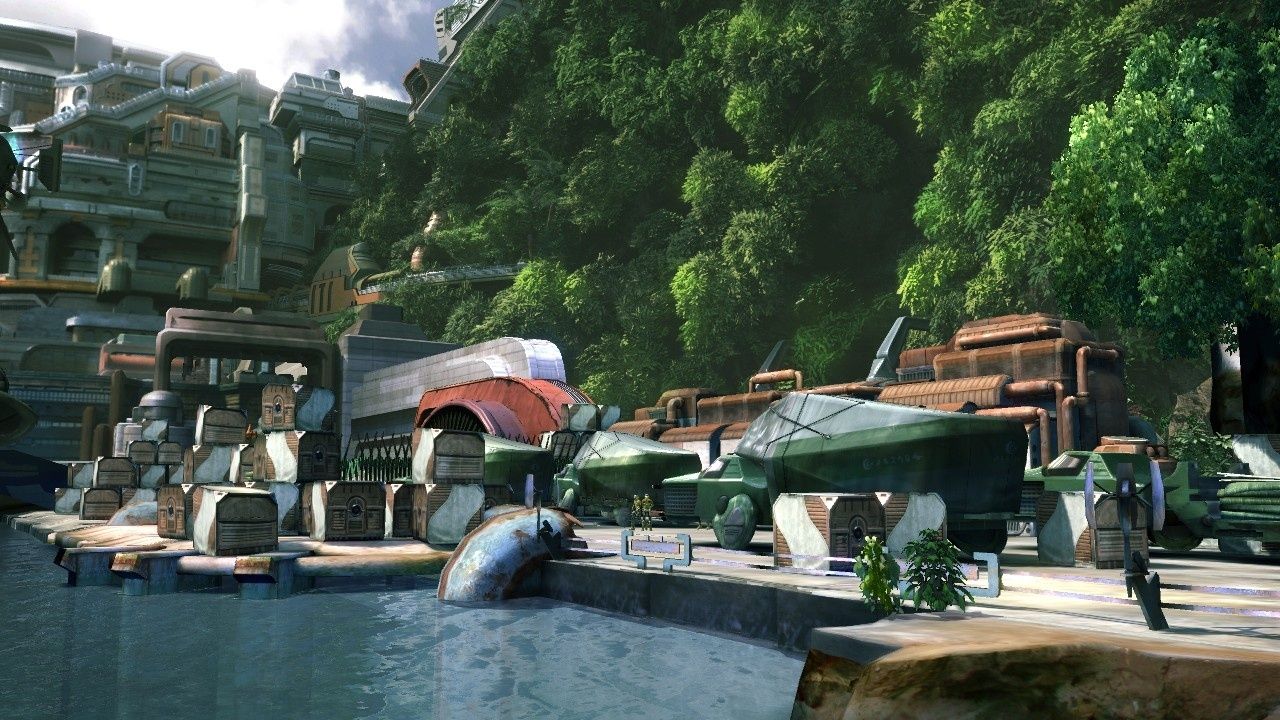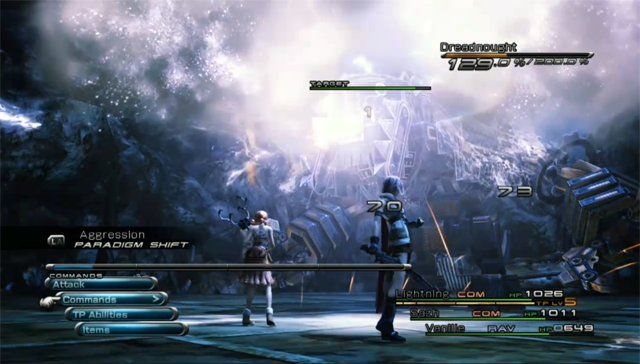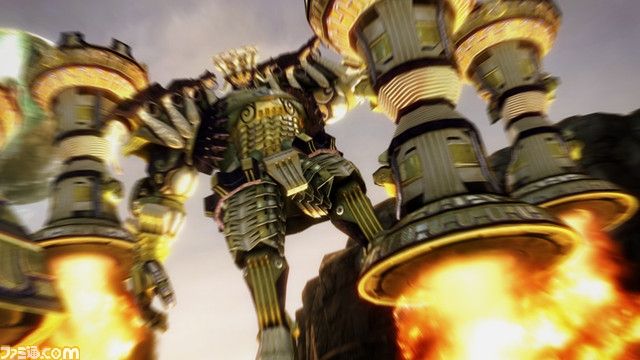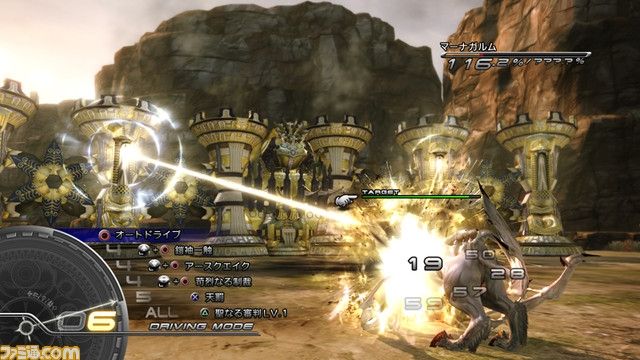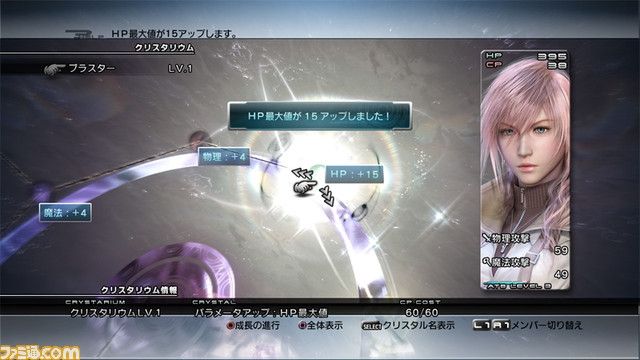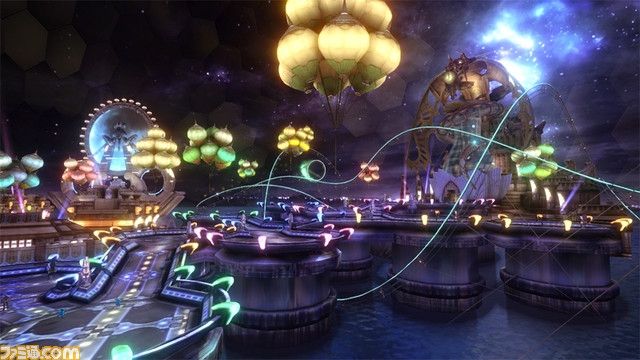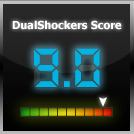I’m a Final Fantasy fan and yes, I freely admit that regardless of what everyone else thinks of the franchise or even individual games specifically, I’ve always been a fan. Sure, it has had its ups and downs, and I by no means think every game is perfect, but I try to see things on an individual basis and go in not without preconceived notions. Thus, my experience with the franchise has always been positive. Like so many other fans, I have been waiting around five years for FFXIII to be released, and to finally get my hands on it and embrace it, regardless of what it brings. However, I don’t blindly ignore all the potential faults that a game may have, as that would be unfair, especially now. That being said, was FFXIII worth the wait? What did I think of it, and how do my reactions to various development decisions compare to that of yours or just the fanbase in general? Read on to find out!
The story of FFXIII is based around the familiar concept of an omnipotent or god-like being controlling the lives of every-day citizens. That is the overreaching theme of the entire game, but there are so many more intricacies and nuances to the plot, characters, and story that I can hardly begin to describe them here. While convoluted in many ways, if you actually make an attempt, the concept of the story is not that difficult to discern, given enough time. These god-like beings, the fal’Cie, use humans to carry out their will. These humans become what are termed l’Cie. The fal’Cie and l’Cie can be either of Cocoon or Pulse origin. Cocoon is a world built and maintained inside a hollowed-out moon by the fal’Cie. This moon floats rather closely above the surface of a wild and wonderful world known as Gran Pulse. In the past, these two worlds fought each other and, to the citizens of Cocoon, Pulse is a “hell”, or so the government and, ultimately, the Cocoon fal’Cie want you to believe. The whole story revolves around breaking apart a belief system, defying assumptions, breaking away from those who wish to control the destiny of millions, regardless the cost. Yes, all of our heroes are Pulse l’Cie, which means they are enemies of Cocoon. Since the majority of the story takes place on Cocoon, they are on the run much of the time.
At the beginning, the story feels incomplete and you have to work to understand what is going on. Most of the time you fail. But, as you progress through the game, all the pieces slowly come together through the use of nicely-done dialog and flash-back cut scenes. The characters - while not always developed completely - do work hard to give you an emotional attachment to them and their relationships, especially in certain cases. There are also some rather un-Final Fantasy-like story moments that are rather dark, which is actually a nice touch. Although, I can't really say the same about the story in general. A large part of it revolves around saving Cocoon - a highly diverse "planet" which you really learn little about. How can you join these characters in their plight if you don't really care about what they're fighting for? The closest the game comes to this is when it brings the family of a few characters into play. However, this ultimately can just be used to explain how well the character relationships are fleshed out throughout the game and does not do a lot to make you care about the big picture. While I believe this is a fault, it does not make the entire story experience horrible by any means. The relationships you, as the player, build with the characters really hit you hard at various points, especially toward the end, and showcases just how strongly this game works to establish that connection.
Final Fantasy XIII has been dumped on by many because of its extreme linearity, even before the game was released. I’m not denying that the game is linear, by any means, but what I want to challenge is how well it worked for the story. Think about it for a minute – the major complaints are that the game is very linear, there are no towns (in the traditional sense), no “slow” periods where you can feel safe and explore, no backtracking during the course of the story, no freedom. Why? Because that IS the story. A group of people branded “enemies of the state” and being hunted by the military will have no time to rest, no freedom to travel around and through towns talking to everyday citizens, and looting their homes. Even when there is the semblance of anonymity at a certain point in the story, it lasts for a scant few moments. The entire mood, energy and, for lack of a better term, linearity, of the first half of the game is supposed to be that way, it is supposed to make you feel confined, like you can’t do anything but move forward, like you’re being chased and on the run. That is what the developers intended, and I challenge that, instead of working against making this a great game, the game is actually a better game for it, because it makes that part of the story more potent, makes the player feel, at least a little, what the characters in the game are feeling – confined, nowhere to run, nowhere being safe. I praise the developers for taking that risk - going against the grain to tell a great story instead of assuming everything has to be as it was before.
While I'm not in the camp that hates the game because it has very little semblance of freedom, even when it "opens up" about half way through, I can't help but still think that opportunities were missed to give a greater sense of freedom at that point. This may be a slight spoiler for some, but most of us know it is going to happen at some point - we eventually arrive on Gran Pulse, after spending the entire front half of the game running for our lives on Cocoon. You have freedom at this point - you can either start doing some of the side quests or head straight to the next story waypoint. As much as I try to justify the linearity of the front half of the game, I seem to think something is lacking here. Gran Pulse is the perfect spot to put a town or settlement of some sort, and provide a more open atmosphere for completing side-quests and these monster hunting missions. It just felt like things were lacking a bit at that point.
Along with the way the story is told, the visuals help draw you into this world, as well. Everything is vibrant and teeming with life, especially once you get to Gran Pulse. It feels like your characters are so insignificant against the vast landscapes; it is worlds apart from the confinement you feel while running for your life on Cocoon. I think this is also intentional, to show that, at least in a way, your characters are more free on Gran Pulse: they no longer really have to run, but they are still searching for answers. The very sleek, modern visuals of Cocoon give way to more aggressive, rustic technology and wide-open, natural areas, making the change in atmosphere much like a brick wall that they slam your head into to make you notice. I also enjoyed the detail of the character models. Just the way the clothes and hair flows, the way the characters move and interact - everything seems fluid with absolutely none of the graphical issues you usually see where weapons intersect the character model. The lips are also synced with the English voices, which actually works to make you feel more at home and more immersed in the dialog sequences.
The audio fits many of the locations to a tee, from intense techno-pop beats in Cocoon’s technology-driven world, to serene instrumentation and tribal drums on Gran Pulse. There are a few lyrical tracks, as well, including the new chocobo theme, which is familiar yet vastly different from what we’ve come to know. The voice work is, for the vast majority of the time, very well done. There are a few awkward moments, but the emotion and character is there, moreso than with any other JRPG I’ve played in recent memory.
One big draw of any RPG is the battle mechanics, and FFXIII doesn’t disappoint. But, like any battle system, it isn’t perfect. In a staunch change in the series, you only control a single individual in battles. Later in the game this can be any person you want out of your six available party members, but for the first half of the game you’re locked in to using certain party members and certain leaders. There is a class system – called “roles” here – but instead of switching each individual’s class, you swap them all at once on the battlefield, to get the results you want for any given situation. These are called paradigms: there are many of them and they vary greatly. There’s a paradigm for just about every situation you can find yourself in, although in typical battles you will likely end up finding the rotation that works best for you. Attacks or other actions are carried out in a similar manner to previous games, with the exception that you have an "Auto" command for whatever role you're currently fulfilling in the active paradigm. If you're attacking, it's "Auto-Attack", if you're debuffing it's "Auto-Hinder" and so on and so forth. While to some this may be a cop-out, an "easy mode" to get around manually selecting commands (which you can also do at will), it is almost certainly needed later in the game when the pace of battle moves so fast that you just aren't given the time you need to activate commands manually. The AI does an excellent job of selecting the right commands automatically that fit the situation and the targeted enemy's weaknesses so you can concentrate on the battle overall instead of what each individual is doing.
Like I mentioned, while you can certainly change to another paradigm that only changes the role of one character, they all “switch” together at the same time. For an all-out-attack formation, you could have Lightning and Vanille be a ravager (black mage) and Fang be a commando (melee damage) – this paradigm is called Relentless Assault. This provides solid damage to quickly dispatch foes, but lacks a healer. If the fight goes south and you need a healer, you would hit L1 and swap to the Diversity paradigm, for example, which retains Lightning as a ravager and Fang as a commando, but swaps Vanille to a medic. When you’re all healed up, swap back to Relentless Assault to finish things off. If it is a tougher fight and you need someone to soak up the damage, perhaps Delta Attack – which includes a commando, a ravager and a sentinel – would be right for you, that way the sentinel can focus all the damage on them and take less of it overall. There are also roles for buffing and debuffing enemies, however I found these used far less often, mostly for special circumstance fights like bosses or eidolons.
Enemies themselves have various strengths and weaknesses, as always, which the party AI reacts to as you fight them (or after you use the Libra technique on them). This comes into play so that you can perform what is called a stagger on the enemy as quickly as possible. In many fights, this is what will make or break the fight. Quite often, staggering an enemy or group of enemies is what leads to the fight being 30 seconds instead of five minutes, or, in extreme cases, it means the difference between life and death. Each enemy has a meter under its name which goes up the more it is attacked. Once it reaches its max, the enemy is staggered and receives many times the amount of damage it usually does. Plus it is susceptible to being launched into the air and, if you time your attacks right, kept there the rest of the fight. After a fight, you are “rated” on your performance, and that rating is based on the amount of time you took to defeat your foes. The “target time” the game generates is based on your party’s overall skill level, equipment level and general effectiveness at the time the fight is initiated. Higher ratings lead to better rewards from the fight.
Another aspect to battle is gaining a preemptive strike. If you sneak up on them without them noticing and initiate combat, all of their combo meters are nearly full, so one hit from any of your party members will send the enemy into stagger mode. By initiating preemptive attacks, your lower-leveled group could take out enemies far out of their level range. The only issue here is that I have the feeling the "target time" for each fight seems to be based more and more on you gaining a preemptive strike as you progress through the game, because I swear no matter how hard I try without it, it is nearly impossible to get a five star rating unless you do so.
Overall, I found the battle system rather overwhelming at first, but the game does a good job of easing you into the craziness that battles become as you progress farther through the story. I still miss being able to control all the characters, and I do think it is not right that you get a “Game Over” screen when only your party leader – the character you are directly controlling – gets knocked out. However, because you can retry fights and, for standard enemies, it starts you back on the field screen instead of the battle screen, this isn’t as big a deal as it sounds. Many times if you simply cannot defeat a group, you can manage to avoid them (and this happens often at about the game’s mid-point onward).
Another thing I enjoyed about the battle system which has connections to the story is the eidolons. There are only six of them, and they are obtained – one per character – throughout the story. These fights are generally very hectic and difficult, because you’re on a timer, but once you obtain them, they can be a serious life-saver in battle. This isn’t because they dish out some serious damage or because they have some fancy limit-break-like visuals to go along with their summoning. No, it is because of the rewards they provide your party when they leave. While they do provide benefits to enemies as well – such as reducing their chain gauge to zero – the benefits they give you far outweigh the drawbacks. If any of your party members are incapacitated, suffering from negative status effects or missing any health whatsoever, they are brought back up to 100% tip-top condition, whether that means they are resuscitated, have status effects removed or healed up fully. Summoning your eidolon is a nice way to rejuvenate the entire party in a rather intense and difficult boss fight. In the most dire situations, they can also be used to avoid the "Game Over" screen when your party leader gets knocked out, as they will sacrifice the rest of their time on-screen to resurrect the leader and heal up the party.
Speaking of difficulty now – while not on the level of Demon’s Souls – this game is still probably the most difficult entry in the Final Fantasy franchise in the last three generations of gaming. It is horribly unforgiving in parts, and not just on boss fights, but on regular enemy groups in general. It does not forgive lack of knowledge about your paradigms and how to use them, although there is no specific set of “must use” paradigms in any given fight. If you don’t have a deep knowledge of them and decent timing to know when to swap them and how to set them up, you will know it when you get completely plowed by a group of enemies time and time again. I find this rather refreshing, for the most part. Fights and knowing the intricacies of the battle system actually matter. When all is said and done, you’re rewarded very well for knowing how to play this game and take advantage of various paradigms. You eventually learn how far you can push yourself, when to hold back and everything in between, and it is a very rewarding way of doing things. While this may come with the territory, I'm not a huge fan of the "trial and error" type game play, but it does work well here because of the available "Retry" option and the fact that a "Game Over" doesn't necessarily mean what it does in other genre titles.
However, I have an issue here, as well. The difficulty seems uneven throughout the whole game. The entire first half of the game, besides a boss fight or two, is pretty easy. It lulls you into a false sense of security to some degree. Then, when you arrive on Gran Pulse, it hits you like a 10 ton hammer in the face: you struggle to fend off even the smallest group of enemies until you start improving your characters. In the following chapter, the enemy groups are pretty easy (or easily avoidable). It would have been nice if there was a more gradual difficulty curve that started way before that magical half way point in the game. Instead of making the front half of the game all a cake walk, start kicking the difficulty up earlier, but smooth the ride a bit, so that it is more of a gradual change instead of an "in your face" reality check. In addition to the uneven difficulty, they couple this with these weird impromptu "boss fights", which really aren't bosses, but may as well be. They tend to do this after long periods between save points, and, just when I think I can finally save after that boss fight, I get thrown into a fight with a mob that might as well be a boss, sometimes completely unprepared. For example, after having free control of my group for about two chapters, I'm pretty set in my ways as to the characters I like. The rest have just been collecting CP and I haven't touched them. Then, suddenly, they once again decide to determine my own groups for me and throw me into one of these pseudo-boss fights with one or two of my under-developed characters and I end up getting ripped a new butt hole.
Outside of the main story which, as I mentioned, is pretty linear, things open up about half way through the game, but only for a short time. Once they do, as I alluded to a bit earlier, you are introduced to the main side quests in the game, which come in the form of monster hunts, similar to the previous entry in the franchise. The difference here is that you can save your game after you complete the story and come back to them. In fact, some you will probably find too difficult to handle before the story ends and you open up the final tier of the characters' development levels - called the Chrystarium. The Chrystarium is most similar to FFX's sphere grid in many ways, and is the convention used here to level up your characters instead of experience. For the most part the Chrystarium is a linear, capped progression for each character. And, by "capped" I mean that you can't really power-level yourself in the strictest sense of the phrase, because at a certain point, you can't go farther in the Chrystarium until you progress the story.
Each character's Chrystarium for the same role may be different, as well. For example, Hope gets Protect and Shell earlier in his synergist Chrystarium than Sazh does, making him better for some things at various points in the game. It all adds to the strategy involved - chosing the right characters for the job at the right times and for the right battles. But, for the most part, a player can pick his favorite party, learn how to use their available roles and paradigms well, and survive in most cases. There are choices to be made within each role's Chrystarium, as well, even though the progression is mostly linear. There are branches that lead to stat bonuses and abilities that you may not want or need at a certain time in the game, which you can skip if you're trying to get to the character's next role level, which increases their effectiveness at that particular job. All in all, while it isn't the most open-ended advancement system seen in recent Final Fantasy titles, it does provide a unique way of going about character progression.
Another means of buffing up your characters is through upgrading equipment, which can be done using the many extraneous items you get to drop off enemies at the end of battles. Weapon upgrading doesn't seem very important during the story part of the game, but in post-game it can really come in handy to get five-star ratings on many of the tougher side-quest marks. My only issue here is that the weapon upgrade system is, for the most part, very confusing. It isn't explained enough in-game to really be useful, so I guess it is a good thing it doesn't seem to be required for story progression. I dabbled in it quite a lot, though, even during the story, so that the characters I enjoyed using had fairly decent weapon levels, which may have made certain encounters a hair easier.
Many of the Final Fantasy staples are here, as well - chocobos, cactuars, Cid, references to earlier games in the franchise as well as some other Square-Enix titles of the past. Moogles are, unfortunately, not present but their essence is there in the form of various shop and item names. The Final Fantasy fan will not be disappointed in this regard. Now, if only they kept the battle win fanfare...
Much of the unwanted aggression toward this title stems from people having unrealistic expectations and completely misunderstanding the purpose of the story and not even thinking beyond, “ZOMG ITZ A STRAT LINEEE!!!111!” If people would stop for a moment and think about what the linearity does for the story and understand what the developers were trying to do, that they were taking a risk and that the story couldn’t be anywhere near the same or have the same impact on the player without the linearity, perhaps things may come across differently. Too many people are stuck on what has been used in the past and are comparing this game to that, when it really should be considered on its own merits alone. The game industry as a whole would not be where it is today without developers breaking the mold, going against the grain and really trying to do something special. Final Fantasy XIII is nothing more than an extension of that.
Ultimately whether you enjoy this game or not is personal opinion, but I hope I've given everyone at least something to think about, regardless if you agree with me or not. This is an outstanding entry in the franchise, but falls just short of being ranked among the best. Ultimately, my biggest issue with the game was the story itself working against the player the majority of the time. I really couldn't figure out how to actually care about the characters' ultimate goal, but I did find myself drawn to the character relationships and development, which was the heart of the story, if not the entire focus. That was the highlight of the narrative for me. This game is touching at the same time that it is frustrating, both mechanically and in being able to understand what is going on at times. Do I think it is as horrible as many people are making it out to be? Not in the least, although certain things could have been better, and I'm obviously not talking about the linearity.
It is going to take a special type of person to latch on to this title - one who is both open minded and a fan of the franchise. Perhaps it is too "interactive movie" for some, perhaps the battle system is too different than what has come before for others. To me, it is an engrossing tale with likable characters and a vibrant world, that met my expectations and then some, however it falls short of being one of the premiere titles in the franchise as a whole. Take it for what it is - a visually stunning romp with a typically complex story. I feel you may just enjoy it to some degree by keeping an open mind.
- Game: Final Fantasy XIII
- Platform Reviewed: PS3
- Developer: Square-Enix
- Publisher: Square-Enix
- Release Date: 3/9/2010
- MSRP: $59.99
- Review Copy Info: A copy of this game was provided to DualShockers Inc. by the publisher for purposes of this review.

